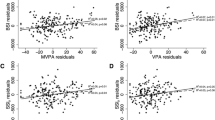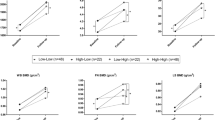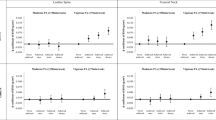Abstract
Summary
The association between baseline physical activity and sedentary time with 2-year longitudinal bone strength was evaluated. The effect of physical activity on bone depended on maturity status. Sedentary time did not negatively impact bone outcomes, regardless of maturity. Maturity should be considered when developing exercise interventions to improve bone outcomes.
Introduction
Physical activity during adolescence is important to obtain peak bone mass; however, adolescents are increasingly sedentary, potentially increasing risk for osteoporosis later in life. The aim of this study was to assess the association of physical activity and sedentary time with 2-year longitudinal bone outcomes in adolescent females (69% Hispanic/31% non-Hispanic).
Methods
Bone strength was assessed at the 66% tibia, 20% femur, and 66% radius of 9- to 12-year-old girls (n = 131) using peripheral quantitative computed tomography at baseline and 2-year follow-up. Physical activity and sedentary time were assessed via accelerometry. Linear regression analyses were used to assess whether baseline vigorous physical activity (VPA), moderate physical activity (MPA), light physical activity (LPA), or sedentary time predict longitudinal bone outcomes, adjusting for relevant confounders.
Results
Significant interactions were found between maturity offset and physical activity. In weight-bearing bones, significant interactions were primarily identified between VPA and maturity offset. Interactions indicated that VPA was associated with favorable bone outcomes at the tibia and femur in girls further past the age of PHV. However, this favorable effect was not observed in girls closer to the age of PHV. At the radius, interactions were primarily observed between LPA and maturity offset. Again, LPA was more beneficial for girls further past the age of PHV. Sedentary time did not significantly influence bone outcomes.
Conclusion
The effects of physical activity on bone may be dependent on maturity. Therefore, physical activity interventions, with attention to maturity status, may be required to optimize bone strength in girls.


Similar content being viewed by others
References
Weaver CM, Gordon CM, Janz KF, Kalkwarf HJ, Lappe JM, Lewis R, O’Karma M, Wallace TC, Zemel BS (2016) The National Osteoporosis Foundation’s position statement on peak bone mass development and lifestyle factors: a systematic review and implementation recommendations. Osteoporos Int 27(4):1281–1386. https://doi.org/10.1007/s00198-015-3440-3
Baxter-Jones AD, Faulkner RA, Forwood MR, Mirwald RL, Bailey DA (2011) Bone mineral accrual from 8 to 30 years of age: an estimation of peak bone mass. J Bone Miner Res 26(8):1729–1739
MacKelvie KJ, Khan KM, McKay HA (2002) Is there a critical period for bone response to weight-bearing exercise in children and adolescents? A systematic review. Br J Sports Med 36(4):250–257
Bailey DA, Martin AD, McKay HA, Whiting S, Mirwald R (2000) Calcium accretion in girls and boys during puberty: a longitudinal analysis. J Bone Miner Res 15(11):2245–2250. https://doi.org/10.1359/jbmr.2000.15.11.2245
Kohrt WM, Bloomfield SA, Little KD, Nelson ME, Yingling VR, American College of Sports Medicine (2004) American College of Sports Medicine position stand: physical activity and bone health. Med Sci Sports Exerc 36(11):1985–1996
Piercy KL, Troiano RP, Ballard RM, Carlson SA, Fulton JE, Galuska DA, George SM, Olson RD (2018) The physical activity guidelines for Americans. JAMA 320(19):2020–2028
Treuth MS, Catellier DJ, Schmitz KH, Pate RR, Elder JP, McMurray RG, Blew RM, Yang S, Webber L (2007) Weekend and weekday patterns of physical activity in overweight and normal-weight adolescent girls. Obesity 15(7):1782–1788
Chastin SF, Mandrichenko O, Skelton DA (2014) The frequency of osteogenic activities and the pattern of intermittence between periods of physical activity and sedentary behaviour affects bone mineral content: the cross-sectional NHANES study. BMC Public Health 14(1):4
Webber LS, Catellier DJ, Lytle LA, Murray DM, Pratt CA, Young DR, Elder JP, Lohman TG, Stevens J, Jobe JB (2008) Promoting physical activity in middle school girls: trial of activity for adolescent girls. Am J Prev Med 34(3):173–184
Matthews CE, Chen KY, Freedson PS, Buchowski MS, Beech BM, Pate RR, Troiano RP (2008) Amount of time spent in sedentary behaviors in the United States, 2003–2004. Am J Epidemiol 167(7):875–881. https://doi.org/10.1093/aje/kwm390
Gabel L, Macdonald HM, Nettlefold L, Mckay HA (2017) Physical activity, sedentary time, and bone strength from childhood to early adulthood: a mixed longitudinal HR-pQCT study. J Bone Miner Res 32(7):1525–1536
Osborn W, Simm P, Olds T, Lycett K, Mensah FK, Muller J, Fraysse F, Ismail N, Vlok J, Burgner D, Carlin JB, Edwards B, Dwyer T, Azzopardi P, Ranganathan S, Wake M (2018) Bone health, activity and sedentariness at age 11-12 years: cross-sectional Australian population-derived study. Bone 112:153–160. https://doi.org/10.1016/j.bone.2018.04.011
Tan VP, Macdonald HM, Gabel L, McKay HA (2018) Physical activity, but not sedentary time, influences bone strength in late adolescence. Arch Osteoporos 13(1):31. https://doi.org/10.1007/s11657-018-0441-9
Koedijk J, van Rijswijk J, Oranje W, van den Bergh J, Bours S, Savelberg H, Schaper N (2017) Sedentary behaviour and bone health in children, adolescents and young adults: a systematic review. Osteoporos Int 28(9):2507–2519
Kontulainen S, Johnston J, Liu D, Leung C, Oxland T, McKay H (2008) Strength indices from pQCT imaging predict up to 85% of variance in bone failure properties at tibial epiphysis and diaphysis. J Musculoskelet Neuronal Interact 8(4):401–409
Lohman TG, Roche AF, Martorell R (1988) Anthropometric standardization reference manual, vol 177. Human Kinetics, Champaign
Hetherington-Rauth M, Bea JW, Lee VR, Blew RM, Funk J, Lohman TG, Going SB (2017) Comparison of direct measures of adiposity with indirect measures for assessing cardiometabolic risk factors in preadolescent girls. Nutr J 16(1):15. https://doi.org/10.1186/s12937-017-0236-7
Marshall WA, Tanner JM (1969) Variations in pattern of pubertal changes in girls. Arch Dis Child 44(235):291–303
Mirwald RL, Baxter-Jones AD, Bailey DA, Beunen GP (2002) An assessment of maturity from anthropometric measurements. Med Sci Sports Exerc 34(4):689–694
Going S, Lohman T, Houtkooper L, Metcalfe L, Flint-Wagner H, Blew R, Stanford V, Cussler E, Martin J, Teixeira P (2003) Effects of exercise on bone mineral density in calcium-replete postmenopausal women with and without hormone replacement therapy. Osteoporos Int 14(8):637–643
Bea JW, Cussler EC, Going SB, Blew RM, Metcalfe LL, Lohman TG (2010) Resistance training predicts 6-yr body composition change in postmenopausal women. Med Sci Sports Exerc 42(7):1286–1295. https://doi.org/10.1249/MSS.0b013e3181ca8115
Farr JN, Chen Z, Lisse JR, Lohman TG, Going SB (2010) Relationship of total body fat mass to weight-bearing bone volumetric density, geometry, and strength in young girls. Bone 46(4):977–984. https://doi.org/10.1016/j.bone.2009.12.033
Stratec Medizintchnik XCT (2004) 3000 manual, software version 6.0. Pforzheim, Germany
Blew RM, Lee VR, Farr JN, Schiferl DJ, Going SB (2014) Standardizing evaluation of pQCT image quality in the presence of subject movement: qualitative versus quantitative assessment. Calcif Tissue Int 94(2):202–211
Shedd KM, Hanson KB, Alekel DL, Schiferl DJ, Hanson LN, Van Loan MD (2007) Quantifying leisure physical activity and its relation to bone density and strength. Med Sci Sports Exerc 39(12):2189–2198. https://doi.org/10.1249/mss.0b013e318155a7fe
Vanhelst J, Vidal F, Drumez E, Béghin L, Baudelet J-B, Coopman S, Gottrand F (2019) Comparison and validation of accelerometer wear time and non-wear time algorithms for assessing physical activity levels in children and adolescents. BMC Med Res Methodol 19(1):72
Evenson KR, Catellier DJ, Gill K, Ondrak KS, McMurray RG (2008) Calibration of two objective measures of physical activity for children. J Sports Sci 26(14):1557–1565
Tan VP, Macdonald HM, Kim S, Nettlefold L, Gabel L, Ashe MC, McKay HA (2014) Influence of physical activity on bone strength in children and adolescents: a systematic review and narrative synthesis. J Bone Miner Res 29(10):2161–2181
Janz KF, Gilmore JM, Levy SM, Letuchy EM, Burns TL, Beck TJ (2007) Physical activity and femoral neck bone strength during childhood: the Iowa Bone Development Study. Bone 41(2):216–222
Janz KF, Letuchy EM, Burns TL, Eichenberger Gilmore JM, Torner JC, Levy SM (2014) Objectively measured physical activity trajectories predict adolescent bone strength: Iowa Bone Development Study. Br J Sports Med 48(13):1032–1036. https://doi.org/10.1136/bjsports-2014-093574
Ducher G, Bass SL, Saxon L, Daly RM (2011) Effects of repetitive loading on the growth-induced changes in bone mass and cortical bone geometry: a 12-month study in pre/peri-and postmenarcheal tennis players. J Bone Miner Res 26(6):1321–1329
Ivuškāns A, Mäestu J, Jürimäe T, Lätt E, Purge P, Saar M, Maasalu K, Jürimäe J (2015) Sedentary time has a negative influence on bone mineral parameters in peripubertal boys: a 1-year prospective study. J Bone Miner Metab 33(1):85–92
Vaitkeviciute D, Lätt E, Mäestu J, Jürimäe T, Saar M, Purge P, Maasalu K, Jürimäe J (2014) Physical activity and bone mineral accrual in boys with different body mass parameters during puberty: a longitudinal study. PLoS One 9(10):e107759
Janz KF, Letuchy EM, Eichenberger Gilmore JM, Burns TL, Torner JC, Willing MC, Levy SM (2010) Early physical activity provides sustained bone health benefits later in childhood. Med Sci Sports Exerc 42(6):1072–1078. https://doi.org/10.1249/MSS.0b013e3181c619b2
Gunter KB, Almstedt HC, Janz KF (2012) Physical activity in childhood may be the key to optimizing lifespan skeletal health. Exerc Sport Sci Rev 40(1):13–21
Cooper AR, Goodman A, Page AS, Sherar LB, Esliger DW, van Sluijs EM, Andersen LB, Anderssen S, Cardon G, Davey R (2015) Objectively measured physical activity and sedentary time in youth: the International Children’s Accelerometry Database (ICAD). Int J Behav Phys Act 12(1):113
Acknowledgments
This study was executed at the University of Arizona, Collaboratory for Metabolic Disease Prevention and Treatment.
Funding
This study was funded by the National Institute of Child Health and Human Development (Award #HD074565).
Author information
Authors and Affiliations
Corresponding author
Ethics declarations
The study protocol was approved by the University of Arizona Human Subjects Protection Committee. Written informed assent and consent was obtained from all participants and their parents or legal guardians, respectively.
Conflicts of interest
None.
Additional information
Publisher’s note
Springer Nature remains neutral with regard to jurisdictional claims in published maps and institutional affiliations.
Rights and permissions
About this article
Cite this article
Bland, V., Bea, J., Roe, D. et al. Physical activity, sedentary time, and longitudinal bone strength in adolescent girls. Osteoporos Int 31, 1943–1954 (2020). https://doi.org/10.1007/s00198-020-05406-z
Received:
Accepted:
Published:
Issue Date:
DOI: https://doi.org/10.1007/s00198-020-05406-z




